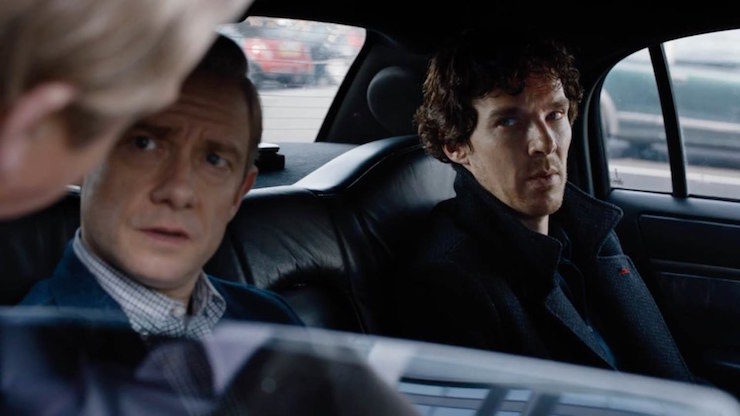Sherlock has reached the midpoint of its current season, and slammed us with a massive reveal. Let’s get nitty-gritty with the “The Lying Detective.”
Spoilers for Sherlock 4×02 “The Lying Detective.”
Summary
Culverton Smith, a wealthy philanthropist, gathers his close friends and his daughter Faith together and administers a drug to the group to help them forget the secret he needs to get off his chest. He tells them that he needs to kill someone. Faith tries to write down what she remembers of the conversation, but he stops her and tells her to hand over the sheet of paper with what she’s written. John is in therapy with a new person who is encouraging him to accept his difficulties in the grieving process, but John isn’t having it. He also refuses to admit that he’s been hallucinating Mary all over the place, and speaking to her. An Aston Martin pulls up at his therapist’s door; it’s Mrs. Hudson, here to tell him that Sherlock has been off his head on cocaine all this time and that he needs to help him.
Sherlock has spent the past weeks in a fugue of drugs and deduction. At one point, Faith Smith came to see him and talk about the notes she wrote after being witness to her father’s confession. She told Sherlock that the one word she couldn’t remember—who her father wanted to kill—has haunted her to this day. He realized that she was suicidal and took her out for chips, getting rid of the gun in her bag as payment for taking her case. She told him that she hadn’t expected him to be nice, and then the drugs knocked Sherlock out for a spell before he woke up to find her vanished. He then deduced that the word that had haunted her was “anyone”: Culverton Smith is a serial killer, and Sherlock publicly accused him on Twitter and his blog.
Back in the present, Mrs. Hudson reveals that she drove Sherlock to John in the boot of her car. It turns out that Sherlock already knew this would happen, and arranged to have everyone meet John here at his therapist’s place, knowing which therapist John would pick, and that fact that he would want Molly to confirm his drug use, and that Culverton Smith would ask to see him that day and send a car to pick them up. Molly confirms that if Sherlock keeps using at this rate, he’ll die in weeks, then the two head out to meet Smith. The man is odious and suspicious to fault, then takes the two to the wing of a local hospital that he built and show them his favorite room: the mortuary. Sherlock had called Faith to the scene, seeming to think that her presence would cow her father, but when she arrives, she is not the woman who came to Sherlock’s flat at all. Sherlock has a breakdown over this, and pulls a scalpel on Smith, leaving John to subdue him. But John gets carried away and beats Sherlock in anger for what happened to Mary. Smith attempts to stop him, but Sherlock says John has a right.
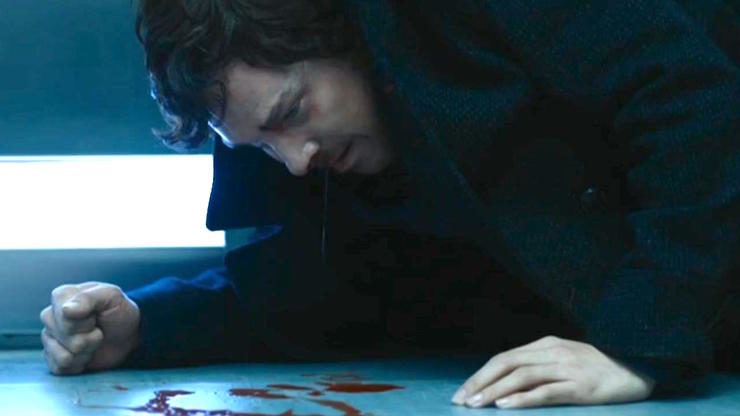
Sherlock is being kept at the hospital, and Smith visits him through a secret passage—he had them built into “his” wing of the building, just like the infamous H. H. Holmes house, so that he could visit patients and satisfy his desire to kill. He asks why Sherlock did this, and Sherlock admits that he wanted Smith to confess the murders to him, even if it killed him. Back at Baker Street, John and Mrs. Hudson find Mycroft and his goons combing over the place. Mycroft is adamant that this behavior from Sherlock doesn’t make sense given his rational approach. Mrs. Hudson laughs at him, telling Mycroft that Sherlock reacts to things emotionally, which leads them to discover Mary’s video message. Mrs. Hudson kicks everyone out but John, and they watch the video in its entirety. Mary gave Sherlock instructions to save John, telling him that he would have to let John save him for it to work. She advised him to pick a fight with a big villain, which is precisely what Sherlock has done. John rushes to the hospital in time to save Sherlock’s life.
John is spending time with Sherlock on rotation with other friends to be certain that he won’t use again. It comes to light that it’s Sherlock’s birthday when John hears Irene Adler’s text message alert, and realizes that she’s still alive. He advises Sherlock to find her and actually attempt a relationship because there was no telling how much time anyone had. He tells Sherlock that Mary’s death wasn’t his fault, then admits to having an affair with a woman he met on the bus… but only via text messages. He apologizes to the figment of Mary in his head and has a breakdown. Sherlock gets to his feet and draws John into a hug. Later, John goes back to his therapist and notices that something’s amiss. It turns out that his therapist is the woman who pretended to be Faith to Sherlock. She’s also the woman that John was having his affair with. She reveals herself to be Eurus Holmes—named for the east wind—Sherlock and Mycroft’s sister. Then she pulls a gun on John and pulls the trigger.
Commentary
I wanna be all like Darth Vader right now: “Sister! So… you have a twin sister!”
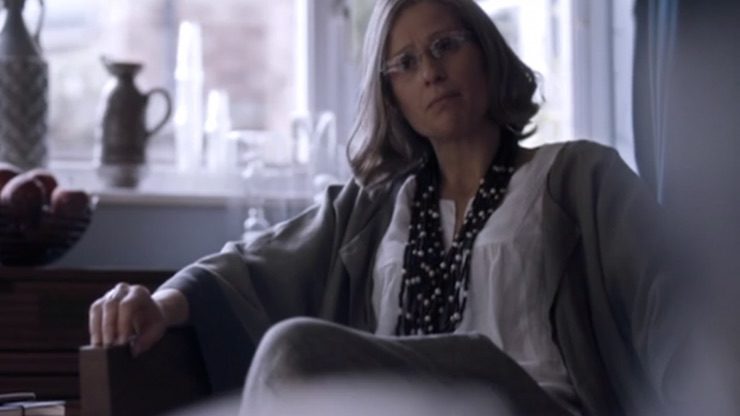
Fine, we have no idea if she’s Sherlock’s twin, but a) that’s usually a thing in these sorts of surprise hidden sibling stories, and b) Sherlock said to John in “The Six Thatchers” that “it’s never twins.” Often in this show, little throwaway lines from other cases come back like that, so… someone is probably a twin. Maybe it’s Eurus and Sherlock, maybe it’s Mycroft and Sherrinford, but someone. Probably.
Oh right, I should also mention that I’m assuming that Sherrinford and Eurus are two different people and that there are actually four Holmes siblings now. Euros could be Sherrinford, but that seems unlikely, since she lists all three names to John after her own, saying that her parents picked odd ones. Their poor parents. How did they ever survive with so many weird genius babies?
There are a lot of great things in this episode in terms of character work. John is working through his grief in a detailed and painful manner, and Sherlock continues to believe that he functions at max capacity or better when he’s high as an airplane, despite all evidence to the absolute contrary. Watching the story bring the two back together is beautifully done and heartbreaking, to boot. Amanda Abbington is clearly having a blast playing the Mary in John’s head, and she does an incredible job of making the figment eerie and funny and commanding all at once. (Not super pleased with the device, since having her there in John’s head is a really fun thing to play, but still ultimately a way for Mary to be there without being a complete person.)
One theme that we’ve been seeing more and more of since the third season is a real close look at Sherlock’s life as a drug addict, something that was ghosted over in the beginning. Sherlock deserves credit for not shying away from this aspect of the character, and does a good job of refusing to glamorize his state while still keeping the canon conceit that Sherlock uses drugs to help himself solve cases. The reappearance of Bill Wiggins adds further credence to this, making it clear that Sherlock has a different sphere of people he engages with while he’s in that headspace, and that they take up real room in his life. The only question is whether or not this will be central to the upcoming finale, and whether or not the show is attempting to address his state in a meaningful way.
The episode is also supremely clever in using the machinations of the performance world against us. It is fairly hard to tell that fake “Faith,” John’s therapist, and the woman he was having an affair with are all the same person for two reasons—she’s well made-up in each incarnation, and we get so accustomed to seeing similar actors in TV and film and we often don’t question people looking incredibly similar. Unless you’ve got great knack for faces, it’s likely that you didn’t notice these three women were the same until the very end. A very nice way of handling something that could have easily given away the game too quickly.
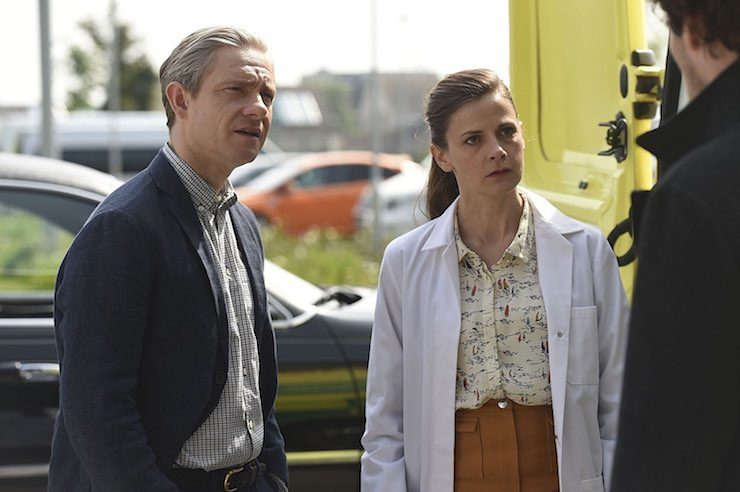
On the one hand, it’s nice that John didn’t have an actual physical relationship when he chose to have an affair. (And I also appreciate that he considers it to be cheating even without sex, because he’s an adult and understands that emotional cheating is a thing.) On the other hand, it seems like the choice to handle it this way was out of a desire to make this another “gotcha!” moment in the series. They tease the audience by making it seem like John was having a full-fledged affair, then rein it in by saying “oh, but it was just texting” so the audience had a week to be aggravated with the character before realizing that it maybe wasn’t as bad as they thought. Which is manipulative in an annoying way rather than a clever one. Also, it smacks of “oh right, we can’t let John sleep with Sherlock’s sister, so we have to mess around with this a bit to make it work.” (I’m not going to get into the whole guy-has-best-friend-and-everyone-thinks-they’re-gay-then-guy-has-crush-on-bffs-sister-what-nothing-it’s-different trope/subtext because at this point, with this show, the whole thing just seems like overkill. John and Sherlock love each other, the end.)
I think I’ve struck on the thing that’s currently bothering me about this season plot-wise. In the previous seasons, each episode had two sides: the reimagined canon Holmes story and the arc-centered story. And these typically wove together so well because an average episode of Sherlock contained just enough to keep the season arc chugging along while making smart choices in reconstituting an old Holmes tale. But this season we’ve had one reimagining that simply used the old story’s plot as a red herring (“The Six Thatchers”), and now this episode basically replicated the plot of “The Dying Detective” without any truly significant restructuring at all. If you’d read the story, you’d know exactly how the plot with Culverton Smith was going to unfold—the only difference were the extra bits added to play into the season arc.
Unfortunately, this weakness of plot takes away one of the main things that has made Sherlock such a fascinating show: its ability to upgrade Holmes canon with fun, modern twists. Instead, Culverton Smith tries to kill Sherlock so that Sherlock can prove he’s killer, just as the original Doyle story had it… and we get a weird needless aside about H. H. Holmes’s murder house to explain the hospital’s ins and outs. It’s a bit of a letdown in a show that is usually very good about grinding up its source material until it resembles a new dish.
This ending offers up a playground of potential theories, all of which are more wacky than the last. So let’s look at what we (think we) know:
- Eurus means “eastern wind,” which was a phrase in an important story to Sherlock last season
- There are at least three Holmes siblings, now possibly four
- Sherlock is still having that recurring dream with Redbeard and another person
- Mycroft has been meaning to talk to Sherrinford
- Eurus has to be tied to the Moriarty plotline somehow due to giving Sherlock the note that said “Miss Me?”
Clearly something happened in Sherlock’s youth tied to Eurus. My assumption is that his recurring dream is a repressed memory. The question is, of what? His sister’s death (that turns out to be faked)? Something terrible that his sister and/or Mycroft did in their youth? Something horrible that he did as a child? The fact that he even had a sister at all? If it seemed to Sherlock as though she died in a traumatic way, perhaps Sherlock blocked the memory of her entirely. Unlikely, but anything is possible in this context.
If Sherlock does remember her, then it’s likely that he either thinks she’s dead or they’re estranged, explaining why he didn’t recognize her. There’s a clear kinship between them, though—he likes her as Faith Smith and her comment that he is “nice” seems to be true to her opinion, rather than the persona of Faith. Another question; did she simply seed the detail that Faith was suicidal to make Sherlock want to help her? Or was Eurus herself actually suicidal?
Here’s my number one concern: I really really really really really do not want Eurus to be somehow “behind” the whole Moriarty arc. I don’t want her to be Moriarty, or to be the guiding hand behind Moriarty. I also don’t want that to be the case with Mycroft in any capacity (though plots like that have been explored in Holmes pastiches and so forth). It cheapens the character of Moriarty entirely. In addition, there’s something extra annoying about revealing a hidden Holmes sister and having her be automatically evil. (Sherrinford could potentially be a woman and assuage that problem, of course.) It’s also the exact same ploy that occurred when John and Sherlock first met, and he mistook Harry to be a brother rather than a sister. So we’ll see where that ends up.
There is one possibility that intrigues me, even if I don’t like the idea of cutting into Moriarty’s legacy: the idea that Mycroft and/or Eurus were concerned about Sherlock’s descent into drug addiction, and invented Moriarty as a way to occupy him and save his life. That would make the trick seem a little less stagey and over-the-top, and would also play into the concern we’re seeing over Sherlock’s cocaine/meth/whatever else use. It would make emotional sense, even if it still retconned a hefty portion of the show. Undermining Moriarty as he is now is likely to come off cheap no matter how you cut it, but that might take out the sting.
There’s also the possibility that none of this has anything to do without Moriarty, and the use of his likeness was just there to drag Sherlock home. So it’s really all up for grabs at this point.
And then there was this clever thought on Twitter (grab all the first letters):
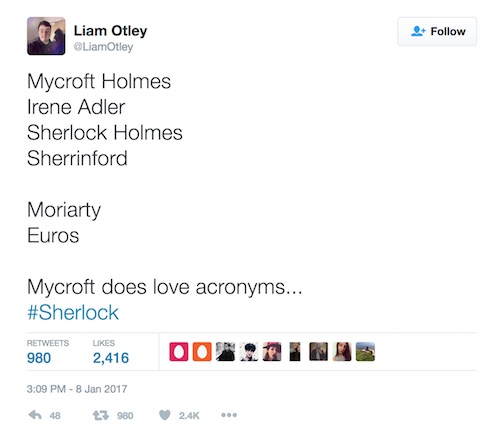
Shoutouts and Unsolved Sundry
- If Molly is just here to take care of babies and diagnose Sherlock’s cocaine usage, I would rather they didn’t write her in at all. No, that’s not true, I’d rather they let Molly do something else, because she’s wonderful and has proved that she’s worth more than this.
- I also miss having Lestrade around in a meaningful capacity. Come back to me, Greg. I long for your incredulousness.
- Irene and Sherlock having this adorable text-sometimes relationship is a really great button on that dynamic. (Is she still teasing him about his funny hat? Are they still making dinner plans?) Also, it was a clever way of wishing Sherlock a happy birthday on his near-birthday—it’s generally thought to be January 6th.
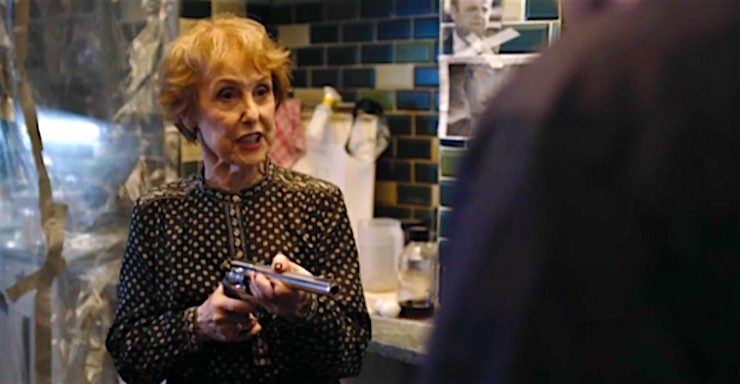
- We get more Bond references, with Mrs. Hudson owning and driving his favorite car (on film, at least), an Aston Martin. And driving it like a maniac with Sherlock in the trunk. That was maybe the greatest moment in the show’s entirety to date. Add to that, they use that moment to explain that OBVIOUSLY Mrs. Hudson is rich if she’s able to own that building in central London and keep a tenant like Sherlock who clearly doesn’t overstress about his rent. Mrs. Hudson for the win, forever.
- Mycroft and Lady Smallwood! Yeah, that was pretty much exactly how I thought Mycroft preferred his dalliances; with boss ladies, in his office. I feel like she’s enough of a match for him that I want this to continue….
Emmet Asher-Perrin wants to drive around with Mrs. Hudson for a day, at any speed. You can bug her on Twitter and Tumblr, and read more of her work here and elsewhere.










